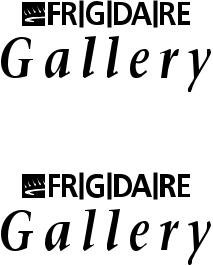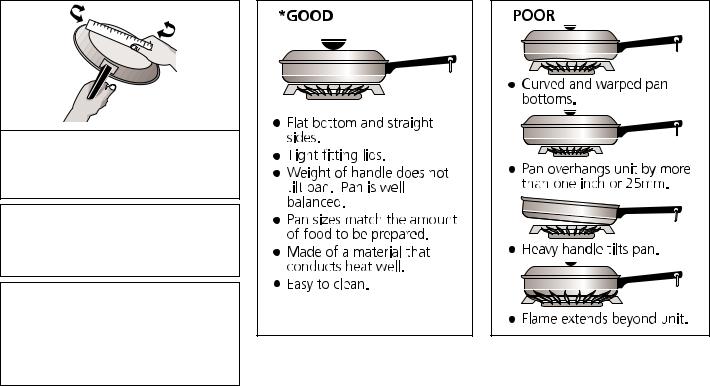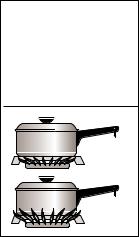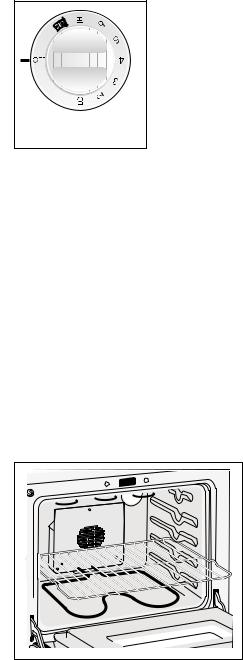Frigidaire FCS388WHC Manual

Dual Fuel
Range
Slide-in Models
and
P r o f e s s i o n a l s e r i e s
O w n e r ’ s
G u i d e
CONTENTS |
|
GENERAL INFORMATION |
..................... 3 |
Avoid Service Checklist ...................... |
18 |
Notes ................................................. |
22 |
Warranty |
|
P/N 318200851 (9903) Rev. B

•ALL RANGES CAN TIP.
•INJURY TO PERSONS COULD RESULT.
•INSTALL ANTI-TIP DEVICE PACKED WITH RANGE.
•SEE INSTALLATION INSTRUCTIONS.



 TO REDUCE THE RISK OF TIPPING OF THE RANGE, THE RANGE MUST BE SECURED BY PROPERLY INSTALLED ANTI-TIP BRACKET(S) PROVIDED WITH THE RANGE. TO CHECK IF THE BRACKET(S) IS INSTALLED PROPERLY, REMOVE THE LOWER PANEL OR STORAGE DRAWER AND VERIFY THAT THE ANTI-TIP BRACKET(S) IS ENGAGED. REFER TO THE I N S T A L L A T I O N INSTRUCTIONS FOR PROPER ANTI-TIP BRACKET(S)
TO REDUCE THE RISK OF TIPPING OF THE RANGE, THE RANGE MUST BE SECURED BY PROPERLY INSTALLED ANTI-TIP BRACKET(S) PROVIDED WITH THE RANGE. TO CHECK IF THE BRACKET(S) IS INSTALLED PROPERLY, REMOVE THE LOWER PANEL OR STORAGE DRAWER AND VERIFY THAT THE ANTI-TIP BRACKET(S) IS ENGAGED. REFER TO THE I N S T A L L A T I O N INSTRUCTIONS FOR PROPER ANTI-TIP BRACKET(S)
Versión en español
Si desea obtener una copia en español de este Manual del Usuario, sírvase escribir la dirección que se incluye a continuación. Solicite la P/N 318201102.
Spanish Owner's Guides
Frigidaire Company
P. O. Box 9061
Dublin, Ohio 43017-0961






 If the information in this manual is not followed exactly, a fire or explosion may result causing property damage, personal injury or death.
If the information in this manual is not followed exactly, a fire or explosion may result causing property damage, personal injury or death.
FOR YOUR SAFETY:
-Do not store or use gasoline or other flammable vapors and liquids in the vicinity of this or any other appliance.
-WHAT TO DO IF YOU SMELL GAS:
•Do not try to light any appliance.
•Do not touch any electrical switch; do not use any phone in your building.
•Immediately call your gas supplier from a neighbor’s phone. Follow the gas supplier’s instructions.
•If you cannot reach your gas
supplier, call the fire department.
- Installation and service must be performed by a qualified installer, servicer or gas supplier.
© 1998 White Consolidated Industries |
2 |
All rights reserved |

G e n e r a l I n f o r m a t i o n
Thank you for choosing this appliance. The information contained within this
Owner's Guide will instruct you on how to properly operate and care for your appliance. Please read through the information contained in your literature pack to learn more about your new appliance.
|
Page |
IMPORTANT SAFETY INSTRUCTIONS ....................... |
4-6 |
SELECTING SURFACE COOKING UTENSILS .................. |
6 |
LIQUEFIED PETROLEUM |
|
(PROPANE) GAS CONVERSION ................................... |
7 |
FLAME SIZE ................................................................ |
7 |
SETTING SURFACE CONTROLS ................................... |
8 |
BEFORE SETTING OVEN CONTROLS ............................ |
8 |
SETTING OVEN CONTROLS ......................................... |
8 |
BEFORE SETTING WARMER DRAWER CONTROL ......... |
9 |
SETTING WARMER DRAWER CONTROL ................ |
9-10 |
CONVECTION COOKING .......................................... |
10 |
CONVECTION ROASTING ......................................... |
10 |
OVEN BAKING .......................................................... |
11 |
AIR CIRCULATION IN THE OVEN ............................... |
11 |
BROILING ................................................................. |
12 |
CHANGING OVEN LIGHT .......................................... |
12 |
GENERAL CLEANING |
|
Cleaning Various Parts of Your Range ................... |
13 |
To Clean the Cooktop Glass .................................. |
14 |
To Clean the Burner Grates, Contoured |
|
Burner Pans, Burner Caps, Burner Bases ........... |
14-15 |
Cleaning the Self-Clean Oven .......................... |
15-16 |
Setting Controls for Clean Cycle ............................ |
16 |
To Remove and Replace Oven Door ....................... |
16 |
Removable Outer Door Glass Panel ....................... |
16 |
To Remove and Replace Warmer Drawer ............... |
17 |
Storage Drawer ..................................................... |
17 |
This owner's Guide contains general operating instructions for your appliance and feature information for several models. Your appliance may not have all the described features.
Note: The instructions appearing in this Owner's Guide are not meant to cover every possible condition and situation that may occur. Common sense and caution must be practiced when installing, operating and maintaining any appliance.
SOME MODELS |
|
|
|
|
|
|
|
||
|
|
|
|
|
|
|
|||
PLEASE DO THIS NOW! |
|
Record the model and serial numbers of this appliance in the space provided |
|
IMPORTANT |
|
|
|||
|
|
|
|
||||||
The PRODUCT |
REGISTRATION |
below. These numbers are shown on the serial plate located at the left of |
|
Keep a copy of your bill of sale. |
|||||
the range frame and are visible when the oven door is open or on the inside |
|
||||||||
CARD should be filled in completely, |
of the drawer along the side of the frame. |
|
The date on the bill establishes the |
||||||
signed, |
and |
returned. |
This |
Model No.: |
|
warranty period should service be |
|||
|
required. Place it where it can be easily |
||||||||
information will |
register |
your |
|
||||||
Serial No.: |
|
retrieved. If service is performed, while |
|||||||
product and help us to serve you |
|
||||||||
Date Purchased: |
|
the |
appliance |
is under |
warranty you |
||||
quickly in the future if the occasion |
|
||||||||
Record these numbers for future reference. |
|
may |
have to |
show your |
bill of sale. |
||||
should |
demand. |
|
|
|
|||||
|
|
|
|
|
|
|
|
||
RecyclablePaper |
|
|
|
|
|
|
318200345 (9809) Rev. A |
||
PRINTED IN CANADA |
|
|
|
|
|
|
|
|
|
General 3 information

IMPORTANT SAFETY INSTRUCTIONS |
Save these instructions for future reference. |
|
Read all instructions before using this appliance. |
|
|
This guide contains important safety symbols and instructions. Please pay special attention to these symbols and follow all instructions given. Here is a brief explanation of the use of these symbols.




 This symbol will help alert you to situations that may cause serious bodily harm, death or property damage.
This symbol will help alert you to situations that may cause serious bodily harm, death or property damage.




 This symbol will help alert you to situations that may cause bodily injury or property damage.
This symbol will help alert you to situations that may cause bodily injury or property damage.
•Remove all tape and packaging wrap before using the appliance. Destroy the carton and plastic bags after unpacking the appliance. Never allow children to play with packaging material.
•Proper Installation—Be sure your appliance is properly installed and grounded by a qualified technician in accordance with National Fuel Gas Code ANSI Z223.1 latest edition, and National Electrical Code ANSI/NFPA No. 70, latest edition. Install and/or adjust only per installation instructions provided in the literature package for this appliance.
Ask your dealer to recommend a qualified technician and an authorized repair service. Know how to disconnect the electrical power to the appliance at the circuit breaker or fuse box and gas supply at the main shut off valve in case of an emergency. Remove the drawer to access the valve.
•User Servicing—Do not repair or replace any part of the appliance unless specifically recommended in the manuals.
All other servicing should be done only by a qualified technician to reduce the risk of personal injury and damage to the appliance.
•Never modify or alter the construction of an appliance by removing leveling legs, panels, wire covers, anti-tip brackets/screws, or any other part of the product.




 Stepping, leaning or sitting on the door or drawer of this appliance can result in serious injuries and may also cause damage to the appliance. Do not allow children to climb or play around the appliance. The weight of a child on an open door may cause the appliance to tip, resulting in serious burns or other injury. An open drawer, when hot, may cause burns.
Stepping, leaning or sitting on the door or drawer of this appliance can result in serious injuries and may also cause damage to the appliance. Do not allow children to climb or play around the appliance. The weight of a child on an open door may cause the appliance to tip, resulting in serious burns or other injury. An open drawer, when hot, may cause burns.




 Do not use the oven or warmer drawer (if equipped) for storage.
Do not use the oven or warmer drawer (if equipped) for storage.
•Storage in or on Appliance—Flammable materials should not be stored in an oven, near surface burners or in the drawer (if equipped). This includes paper, plastic and cloth items, such as cookbooks, plasticware and towels, as well as flammable liquids. Do not store explosives, such as aerosol cans, on or near the appliance. Flammable materials may explode and result in fire or property damage.




 Do not store items of interest to children in the cabinets above the appliance.
Do not store items of interest to children in the cabinets above the appliance.
•Do not leave children alone. Children should not be left alone or unattended in the area where an appliance is in use. They should never be allowed to sit or stand on any part of the appliance.
•DO NOT TOUCH SURFACE BURNERS, GRATES, AREAS NEAR THESE BURNERS, OVEN HEATING ELEMENTS OR INTERIOR SURFACES OF THE OVEN OR WARMER DRAWER (if equipped). Both surface burners and oven heating elements may be hot even though they are dark in color. Areas near surface burners may become hot enough to cause burns. During and after use, do not touch, or let clothing or other flammable materials touch these areas until they have had sufficient time to cool. Among these areas are the cooktop, surfaces facing the cooktop, the oven vent openings and surfaces near these openings, oven door and window.
•Wear Proper Apparel—Loose-fitting or hanging garments should never be worn while using the appliance. Do not let clothing or other flammable materials contact hot surfaces.




 Never use your appliance for warming or heating the room.
Never use your appliance for warming or heating the room.
•Do Not Use Water or Flour on Grease Fires—Smother the fire with a pan lid, or use baking soda, a dry chemical or foam-type extinguisher.
•When heating fat or grease, watch it closely. Fat or grease may catch fire if allowed to become too hot.




 In case of fire or gas leak, be sure to turn off the main gas shut off valve.
In case of fire or gas leak, be sure to turn off the main gas shut off valve.
•Use Only Dry Potholders—Moist or damp potholders on hot surfaces may result in burns from steam. Do not let the potholders touch the flame, burners or interior oven elements. Do not use a towel or other bulky cloth instead of a potholder.
•Do Not Heat Unopened Food Containers—Build up of pressure may cause the container to burst and result in injury.
•Remove the oven door from any unused appliance if it is to be stored or discarded.
•IMPORTANT—Do not attempt to operate the oven during a power failure. If the power fails, always turn the oven off.
If the oven is not turned off and the power resumes, the oven may begin to operate again. Food left unattended could catch fire or spoil.




 Use Proper Flame Size—Adjust flame size so it does not extend beyond the edge of the utensil. The use of undersized utensils will exposed a portion of the burner flame to direct contact and may result in ignition of clothing. Proper relationship of utensil to flame will also improve efficiency.
Use Proper Flame Size—Adjust flame size so it does not extend beyond the edge of the utensil. The use of undersized utensils will exposed a portion of the burner flame to direct contact and may result in ignition of clothing. Proper relationship of utensil to flame will also improve efficiency.
General 4 information
IMPORTANT SAFETY INSTRUCTIONS (continued)




 Do not use stove top grills on the burner
Do not use stove top grills on the burner
grates of sealed gas burners. If you use a stove top grill on a sealed gas burner, it will cause incomplete combustion and can result in exposure to carbon monoxide levels above allowable current standards. This can be hazardous to your health.




 Electronic controllers can be damaged by cold temperatures. When you use your appliance for the first time, or if it has not been used for a long period of time, make sure that it has been exposed to a temperature above 0°C/ 32°F for at least 3 hours before connecting it to the power supply.
Electronic controllers can be damaged by cold temperatures. When you use your appliance for the first time, or if it has not been used for a long period of time, make sure that it has been exposed to a temperature above 0°C/ 32°F for at least 3 hours before connecting it to the power supply.
IMPORTANT INSTRUCTIONS FOR USING YOUR COOKTOP
•Know which knob controls each surface burner. Always turn the knob to the LITE position when igniting the burners. Visually check that the burner has lit. Then adjust the flame so it does not extend beyond the edge of the utensil.
•Use Proper Pan Size—This appliance is equipped with one or more surface burners of different sizes. Select utensils having flat bottoms large enough to cover the surface burner. The use of undersized utensils will expose a portion of the surface burner to direct contact and may result in ignition of clothing. Proper relationship of utensil to the surface burner will also improve efficiency.
•Utensil Handles Should Be Turned Inward and Should Not Extend Over Adjacent Surface Burners—To reduce the risk of burns, ignition of flammable materials, and spillage due to unintentional contact with the utensil. The handle of the utensil should be positioned so that it is turned inward, and does not extend over adjacent surface burners.
•Never Leave Surface Burners Unattended—Boilovers cause smoking and greasy spillovers that may ignite, or a pan that has boiled dry may melt.
•Protective liners— Do not use aluminum foil to line surface burner pans or oven bottom, or any other part of the appliance. Only use aluminum foil as recommended for baking if used as a cover placed on the food. Any other used of protective liners or aluminum foil may result in a risk of electric shock or fire or a short circuit.
•Glazed Cooking Utensils—Only certain types of glass, glass/ ceramic, ceramic, earthenware, or other glazed utensils are suitable for rangetop service without breaking due to the sudden change in temperature. Check the manufacturer's recommendations for rangetop use.
•Do Not Use Decorative Surface Burner Covers. If a burner is accidentally turned on, the decorative cover will become hot and possibly melt. Burns will occur if the hot covers are touched. Damage may also be done to the cooktop or burners because the covers may cause overheating. Air will be blocked from the burner and cause combustion problems.
IMPORTANT INSTRUCTIONS FOR USING YOUR OVEN
•Use Care When Opening Door or Warmer Drawer (if equipped)—Stand to the side of the appliance when opening the door of a hot oven. Let hot air or steam escape before you remove or replace food in the oven/warmer drawer.
•Keep Oven Vent Ducts Unobstructed. The oven is vented at the rear of the cooktop. Touching the surfaces in this area when the oven is operating may cause severe burns. Also, do not place plastic or heat-sensitive items on or near the oven vent. These items could melt or ignite.
•Placement of Oven/Warmer Drawer (if equipped) Racks.
Always place oven racks in desired location while oven/drawer (if equipped) is cool. Remove all utensils from the rack before removing rack. If rack must be moved while oven/drawer is hot, use extreme caution. Use potholders and grasp the rack with both hands to reposition. Do not let potholders contact the hot oven element or interior of the oven/warmer drawer (if equipped).
•Do not use the broiler pan without its insert. The broiler pan and grid allow dripping fat to drain and be kept away from the high heat of the broiler.
•Do not cover the broiler or warmer drawer (if equipped) grid with aluminum foil. Exposed fat and grease could ignite.
•Do not touch a hot light bulb with a damp cloth. Doing so could cause the bulb to break. Disconnect the appliance or turn off the power to the appliance before removing and replacing light bulb.
IMPORTANT INSTRUCTIONS FOR CLEANING YOUR RANGE
•Clean the appliance regularly to keep all parts free of grease that could catch fire. Exhaust fan ventilation hoods and grease filters should be kept clean. Do not allow grease to accumulate. Greasy deposits in the fan could catch fire. Refer to the hood manufacturer's instructions for cleaning.
•Cleaners/aerosols—Always follow the manufacturer's recommended directions for use. Be aware that excess residue from cleaners and aerosols may ignite causing damage and/or injury.
General 5 information

IMPORTANT SAFETY INSTRUCTIONS (continued)
SELF-CLEANING OVENS:
•Clean in the self-cleaning cycle only the parts of the oven listed in this owner's guide. Before self-cleaning the oven, remove the broiler pan and any utensils stored in the oven.
•Do not clean the oven door gasket. The door gasket is essential for a good seal. Care should be taken not to rub, damage or move the gasket.
Selecting Burner Cooking Utensils
•Do not use oven cleaners. No oven cleaner or oven liner protective coating of any kind should be used in or around any part of the oven.
•Remove oven racks. Oven racks color will change if left in the oven during a self-cleaning cycle.
SAVE THESE INSTRUCTIONS
For best result and energy conservation, choose cooking utensils that have these characteristics:
Pans should have flat bottoms. Check for flatness by rotating a ruler across the bottom. There should be no gap between the pan and ruler.
Note: Always use a utensil for its intended purpose. Follow manufacturer's instructions. Some utensils were not made to be used in the oven or on the cooktop.
Note: Do not use griddle on more than one burner. That can damage your cooktop and that can result in exposure to carbon monoxide levels above allowable current standards. That can hazardous to your health.
*Specialty pans such as lobster pots, griddles and pressure cookers may be used but must conform to the above recommended cookware requirements.
General 6 information

Conversion Petroleum (Propane) Gas Conversion
The cooktop can be used with Natural Gas or Propane Gas. It is shipped from the factory for use with natural gas.
If you wish to convert your appliance for use with LP/Propane gas, use the supplied fixed orifices located in a bag containing the literature marked, "FOR LP/PROPANE GAS CONVERSION". Follow the instructions package with the orifices.
The conversion must be performed by a qualified service technician in accordance with the manufacturer's instructions and all codes and requirements of the authority having jurisdiction. Failure to follow instructions could result in serious injury or property damage. The qualified agency performing this work assumes responsibility for the conversion.




 Severe shock or damage to the appliance may occur if the appliance is not installed by a qualified installer.
Severe shock or damage to the appliance may occur if the appliance is not installed by a qualified installer.
Flame Size
Never extend the flame beyond the outer edge of the utensil. A higher flame simply wastes heat and energy, and increases your risk of being burned by the flame.
RIGHT
WRONG
For most cooking, start on the highest control setting and then turn to a lower one to complete the process. Use a chart below as a guide for determining proper flame size for various types of cooking. The size and type of utensil used and the amount of food being cooked will influence the setting needed for cooking.
For deep fat frying, use a thermometer and adjust the surface control knob accordingly. If the fat is too cool, the food will absorb the fat and be greasy. If the fat is too hot, the food will brown so quickly that the center will be undercooked. Do not attempt to deep fat fry too much food at once as the food will neither brown or cook properly.
*Flame Size |
Type of Cooking |
High Flame |
Start most foods; bring water to a boil; pan broiling |
Medium Flame |
Maintain a slow boil; thicken sauces, gravies; steam |
Low Flame |
Keep foods cooking; poach; stew |
|
|
* These settings are based on using medium thickness aluminum pans with lids. Settings may vary when using other types of pans.
General 7 information

Setting Surface Controls
The color of the flame is the key to proper burner adjustment. A good flame is clear, blue and hardly visible in a well-lighted room. Each cone of flame should be steady and sharply defined. Adjust or clean burner if flame is yellow-orange. To clean burner, see instructions under
General Cleaning.
Surface |
Burner |
Control |
|
Knob |
|
Each burner lights automatically from an electric ignitor each |
NOTE: All knobs shown in this |
|
time a control knob is turned to the LITE position. |
||
owner's Guide are typical only. |
||
|
||
|
|
To operate the surface burner:
1.Place cooking utensil on burner.
2.Push in and turn the Surface Control knob counterclockwise to LITE.
3.Visually check that the burner has lit.
4.After the burner ignites, turn the control knob to the desired flame size. The knob can now be turned in either direction without being pushed in. The control knobs do not have to be set at a particular mark. Use the guides and adjust the flame as needed. DO NOT cook with the control knob in the LITE position, as this will cause excess wear on the ignitor electrode.
5.To turn the burner off, turn the control knob clockwise as far as it will go, to the OFF position.
In the event of an electrical power outage, the surface burners can be lit manually. To light a surface burner, hold a lit match to the burner head, then slowly turn the surface control knob to LITE. After the burner ignites, turn the control knob to the desired flame size. Use caution when lighting surface burners manually.
Surface burners in use when an electrical power failure occurs will continue to operate normally.




 Do not operate the burner for an extended period of time without cookware on the grate. The finish on the grate may chip without cookware to absorb the heat.
Do not operate the burner for an extended period of time without cookware on the grate. The finish on the grate may chip without cookware to absorb the heat.




 Do not place plastic items such as salt and pepper shakers, spoon holders or plastic wrappings on top of the cooktop when it is in use. These items could melt or ignite. Pot holders, towels or wood spoons could catch fire if placed too close to a flame.
Do not place plastic items such as salt and pepper shakers, spoon holders or plastic wrappings on top of the cooktop when it is in use. These items could melt or ignite. Pot holders, towels or wood spoons could catch fire if placed too close to a flame.
Before Setting Oven Controls
Oven Vent Location
The oven is vented through at the rear of the cooktop. When the oven is on, warm air is released through the vents. This venting is necessary for proper air circulation in the oven and good baking results. DO NOT block the vents. Doing so may cause cooking failures, fire or damage to the appliance
Arranging Oven Racks
ALWAYS ARRANGE OVEN RACKS WHEN THE OVEN IS COOL (PRIOR TO OPERATING THE
OVEN). Always use oven mitts when using the oven.
To remove an oven rack, pull the rack forward until it stops. Lift up front of rack and slide out.
To replace an oven rack, Fit the rack onto the guides on the oven walls. Tilt the front of the rack upward and slide the rack back into place.
Setting Oven Controls
For oven settings, refer to the time or the electronic oven control section.
General 8 information
